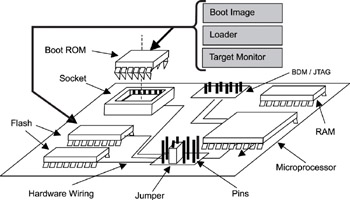Книга: Real-Time Concepts for Embedded Systems
3.2 Target System Tools and Image Transfer
An executable image built for a target embedded system can be transferred from the host development system onto the target, which is called loading the image, by:
· Programming the entire image into the EEPROM or flash memory.
· Downloading the image over either a serial (typically RS-232) or network connection. This process requires the presence of a data transfer utility program on the host system, as well as the presence of a target loader, an embedded monitor, or a target debug agent on the target system.
· Downloading the image through either a JTAG or BDM interface (discussed in section 3.5).
These approaches are the most common, and this list is by no means comprehensive. Some of the possible host-to-target connectivity solutions are shown in Figure 2.1. Figure 3.1 exemplifies a target embedded system. We refer to the ELF image format (introduced in Chapter 2) exclusively throughout this chapter.

Figure 3.1: View of the target embedded system.
The embedded software for the final product is commonly stored in either ROM or the flash memory. The entire executable image is burned into the ROM or flash memory using special equipment. If ROM is used, the ROM chip is set into its socket on the target board. For embedded system boards that have both ROM and flash memory, the next step is to set the necessary jumpers. Jumpers are the part of the target board's wiring that controls which memory chip the processor uses to start executing its first set of instructions upon reboot. For example, if the image is stored in the flash memory and the jumpers are set to use the flash memory, the processor fetches its first instruction from the starting address where the flash is mapped. Therefore, set the jumpers appropriately according to the image storage.
This final production method, however, is impractical during the development stage because developers construct software in incremental steps with high frequency. The process is interactive in that a portion of the code is written, debugged, and tested, and the entire process then repeats for the new code. Reprogramming the EEPROM or the flash memory each time the code changes due to bugs or code addition is time consuming. The methods for downloading the image over a serial or a network connection or for downloading the image through a JTAG or BDM interface solve this problem by transferring the image directly into the target system's RAM memory.
- Разработка приложений баз данных InterBase на Borland Delphi
- Open Source Insight and Discussion
- Introduction to Microprocessors and Microcontrollers
- Chapter 6. Traversing of tables and chains
- Chapter 8. Saving and restoring large rule-sets
- Chapter 11. Iptables targets and jumps
- Chapter 5 Installing and Configuring VirtualCenter 2.0
- Chapter 16. Commercial products based on Linux, iptables and netfilter
- Appendix A. Detailed explanations of special commands
- Appendix B. Common problems and questions
- Appendix E. Other resources and links
- IP filtering terms and expressions




